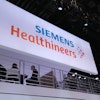A new study indicates that endocrinologists are handling more therapeutic radioiodine procedures for hyperthyroidism and thyroid cancer, taking more of that duty from nuclear medicine physicians and radiologists. A change in physician certification rules could be to blame for the shift, researchers say.
Research from Thomas Jefferson University in Philadelphia, presented at the recent annual RSNA meeting, suggests the trend is due to the U.S. Nuclear Regulatory Commission (NRC) reducing the licensure requirements for nonradiologists, enabling them to become certified for radioiodine procedures after just 80 hours of classroom and laboratory training.
The rules, which eased licensure requirements for physicians who wish to use iodine-131 for the treatment of hyperthyroidism, are contained in the NRC's 10 CFR Parts 35.392 and 35.394.
Medicare data
The study group led by Dr. Charles Intenzo reviewed the national Medicare Part B database that details which Medicare patients are treated by which specialty. All relevant current procedural terminology (CPT-4) codes from the database for 1996 through 2007 were selected for terms including "hyperthyroidism," "thyroid cancer ablation," and "metastatic thyroid cancer ablation."
The goal was to determine if there was a trend regarding physicians performing radioiodine procedures by comparing statistics from 1996 and 2007, the most recent year for which the Medicare data are available.
In 1996, a total of 13,273 radioiodine procedures were performed on Medicare patients. Of that total, radiologists conducted 9,715 cases, while 2,938 procedures were performed by endocrinologists. The remaining 620 patients were handled by other specialists.
In 2007, there were 13,004 radioiodine procedures performed on Medicare patients. Of these, 9,002 were performed by radiologists and 3,976 were conducted by endocrinologists. The remaining patients were handled by other specialists.
| Change in physician share of radioiodine procedures, 1996 versus 2007
|
||||||||||||||||||||
| Source: Thomas Jefferson University and Dr. Charles Intenzo. |
Intenzo also noted that the overall decline of radioiodine procedures from 1996 to 2007 is "somewhat surprising, since the Medicare population certainly hasn't gotten smaller and the incidence of disease has not gotten any lower."
Given the numbers, the researchers concluded that radiologists are "slowly losing market share" in radioiodine therapy to endocrinologists. "Arguably, the reason for that is the NRC," Intenzo said, "because they lowered the licensure requirements for nonradiologists to become certified in doing radioiodine procedures."
Except for the few endocrinologists who perform thyroid biopsies, he noted that endocrinologists "do not do any procedures, so that makes them potentially hungry predators. So this is really the only other procedure they can do."
By Wayne Forrest
AuntMinnie.com staff writer
December 29, 2009
Related Reading
Majority of radiology residents still leery of breast imaging, December 15, 2009
Radiologist salaries inched up in 2008, SalaryScan survey shows, May 14, 2009
Nuke med techs top U.S. labor bureau wage report, May 6, 2009
Survey shows residents have ample job options, September 26, 2008
Survey: Radiologists 50 and older eager for work changes, November 19, 2007
Copyright © 2009 AuntMinnie.com




















